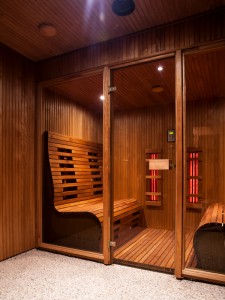
There are a lot of reasons to spend time relaxing in a sauna. Aside from the obvious benefits of relaxing your body and mind, saunas provide an opportunity to improve your skin health and eliminate toxins from your body. Saunas are a common fixture in fitness centers and gyms across the country. They are so popular that when homeowners see a sauna for sale they have to think long and hard about investing in one for their home. If you've never looked at saunas for sale, you might be surprised to know that there are actually two types of saunas commonly sold today.
When so many people step into a sauna, enjoy the relaxing heat, and go on about their day, it's no surprise that most people aren't familiar with the different types of saunas. The most common saunas for sale today are infrared and traditional models. What is the difference between the two, and which one is right for you?
Heat
The biggest difference between the two types of saunas is the intensity of the heat. A traditional dry sauna heats up to temperatures between 185 and 195 degrees, while an infrared model tops out between 120 and 150 degrees. The milder temps in an infrared sauna allow you to remain in the sauna for a longer period of time, permitting the heat waves to reach deeper into your body and creating a more relaxed physical state. Traditional saunas induce a more intense sweat, helping the body eliminate toxins and boost circulation in your blood stream.
Humidity
Traditional saunas start the day as a low-humidity environment, but when more people use it throughout the day, humidity levels begin to rise. Every time a user pours water on the coals in a traditional sauna, more humidity is released into the air in the sauna. Infrared saunas have no coals and create no steam, making it a low-humidity environment.
Power
If you've seen an infrared sauna for sale and wondered how it might impact your electricity bill, you might be surprised to learn how little the impact is on your budget. Infrared saunas use an average of 1.6 kw, while traditional saunas use an average of 6 kw of power. Comparatively speaking, infrared saunas will cost you one-third the amount a traditional sauna would on your energy bill.
Heat Source
As alluded to in the humidity section, infrared and traditional saunas use different heat sources to provide you with a relaxing environment. A traditional sauna uses a stove to heat the air inside. When water is added to the coals on the stove, you boost the humidity inside the sauna. Infrared saunas, on the other hand, use infrared heating panels that emanate a lower level of heat into the sauna. The differing heat sources create different environments for your body.
The higher heat in a traditional sauna causes your body to start cooling itself by transporting blood closer to the surface. This not only helps maintain healthy skin, but the high heat causes sweating which opens the pores. Infrared saunas use lower heat levels to penetrate deeper into your skin, causing a slower rise in body temperature. The overall impact is a deep, relaxing heat that eases arthritic pain and soothes muscles.
Before you buy that sauna for sale that you saw online, keep these factors in mind and determine which type of sauna is right for you based upon its features and your needs














